8+ Sample Event Emergency Action Plan
-
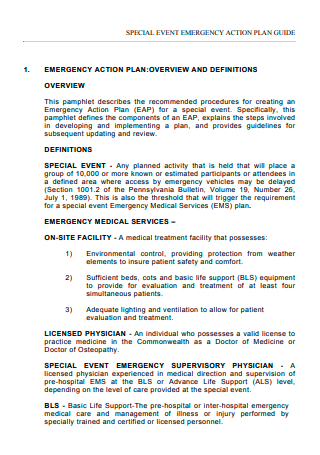
Special Event Emergency Action Plan Template
download now -
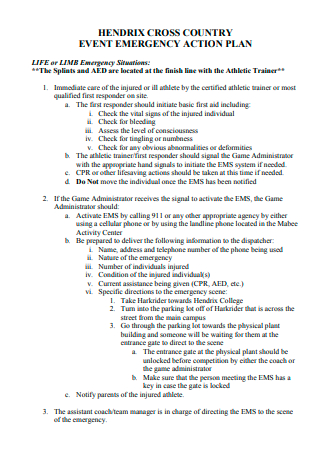
Printable Event Emergency Action Plan
download now -
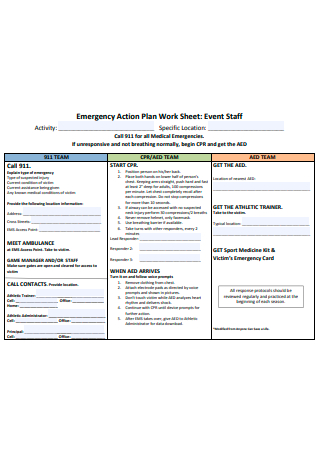
Event Staff Emergency Action Plan Worksheet Templat
download now -

Event Emergency Action Plan in PDF
download now -
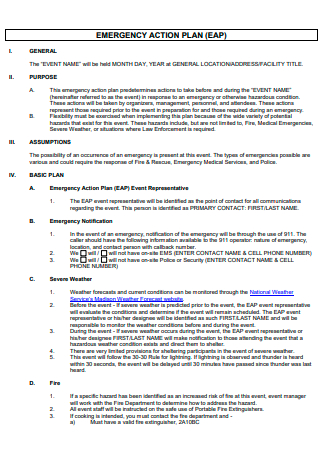
Basic Event Emergency Action Plan
download now -
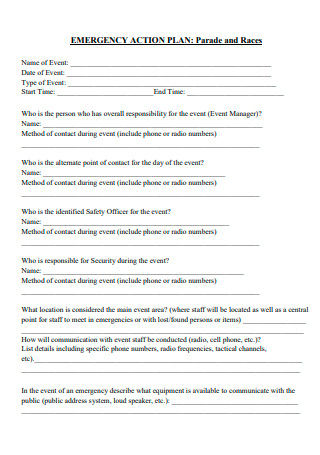
Formal Event Emergency Action Plan
download now -
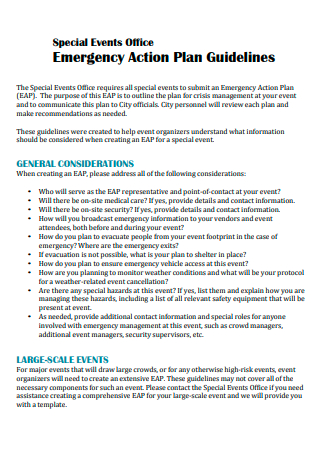
Special Event Office Emergency Action Plan
download now -
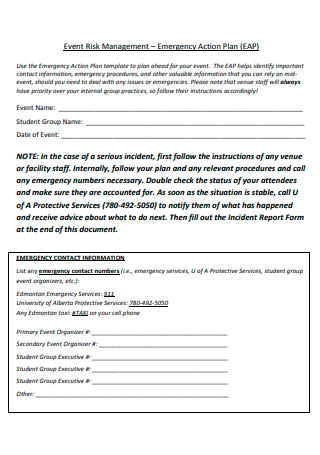
Event Risk Management Emergency Action Plan
download now -
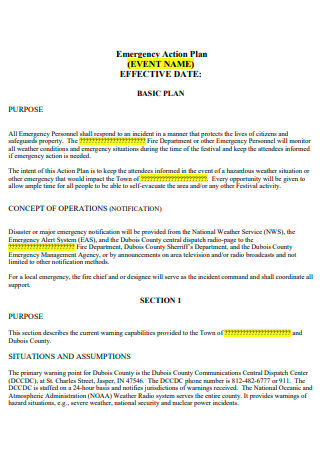
Event Emergency Action Plan Example
download now
FREE Event Emergency Action Plan s to Download
8+ Sample Event Emergency Action Plan
What Is an Event Emergency Action Plan?
How to Make an Event Emergency Action Plan
Tips for Creating an Event Emergency Action Plan
Emergency Procedures
FAQs
What is a workplace emergency?
Why is planning for emergencies important for events?
How can I prepare for an emergency?
What Is an Event Emergency Action Plan?
An Emergency Action Plan for an event is a written document created by the event companies or organizers to validify a public events permit and identify potential emergencies at the event site. Where the event team or crew can define what to do in the case of an emergency. Emergency management is greatly encouraged to avoid dangerous situations if they ever occur. An emergency breaking out is not avoidable because natural phenomena may happen or man-made actions may lead to that situation. This is why before an event takes place, coming up with an event emergency action plan is necessary. You can check out the emergency action plan example that this article provides.
How to Make an Event Emergency Action Plan
Not every planned special event goes according to plan. Some occurrences are beyond your control. Each of your involved event team has the responsibility to safeguard and minimize the effects of an emergency at a scheduled event to ensure the safety of your community and guests. Through an event emergency action plan, organizers or part of the event team will also be aware of what to do if an emergency comes up. Read more about them as you continue to go through the article. As well as be guided with the steps this article will take to show you how to make an Event emergency action plan.
Step 1: Include the Location Map
People must respond fast in an emergency, and knowing where to go and how to get there is frequently a vital element of that response. People will either need to evacuate the building as fast as possible or be prepared to navigate to a safer portion of the structure, depending on the type of emergency. Every written event emergency action plan should include current floor layouts and an up-to-date floor plan for the whole Facility. All emergency exits should be immediately recognized, and the floor layout should contain indicated evacuation routes.
Step 2: Reporting and Alerting Authorities
The majority of situations will necessitate the assistance of law enforcement, fire and rescue, and Medical personnel. As a result, someone in the event team must be assigned to make the call. Nothing is more frustrating than a delayed response because everyone believed authorities had been called by someone else. It’s worth noting that some catastrophes will necessitate the use of expert emergency personnel. Make sure the event emergency action plan has all of the necessary emergency numbers and contact information.
Step 3: Alerting Staff and Visitors of an Emergency
In addition to notifying the appropriate authorities, it is critical to inform all employees and visitors that an emergency has occurred. The particular manner of communication will depend on the facility’s size and architecture. A Fire alarm may be activated to inform everyone when a fire has started. It’s crucial to remember that certain crises don’t necessitate notifying everyone in the building. If it is an individual suffering from a medical emergency, then there is no need to inform others unaffected. Medical emergencies should be catered in the event emergency action plan, involving getting medical assistance from those trained in first aid to assist in the victim’s stabilization.
Step 4: Accounting for Everyone after Implementation
The next step is to set a location to regroup after initiating and performing an event emergency action plan. It will be crucial to determine whether or not anyone was lost or hurt throughout the procedure. Breaking up huge companies into manageable units is the best way to do this. These groups are usually grouped around departments or specific physical regions inside the building, but they can be formed in any way that makes sense for your company. It’s also a good idea to have each group gather in a specific place so that checking everyone in is easy.
Step 5: Notifying Relatives
Following the activation of an event emergency action plan, it may be required to contact the affected person’s relatives or whoever went with them to the event. Family members may need to be notified right away to provide information or come take up their minor children, depending on the scenario. A good event emergency action plan will specify who is responsible for notifying family members, what crises warrant family notification, and what information should be sent. It’s also critical to keep all members’ Contact Information up to date.
Tips for Creating an Event Emergency Action Plan
According to a FEMA survey, 65 percent of Americans have sought disaster preparation information, and 48 percent have established emergency plans. Although this may appear to be a high percentage, not everyone will be prepared to deal with an emergency. At any time, disaster can strike. Because we never know when or where an emergency will occur, you and your event organization must be prepared. An event emergency action plan is a useful tool for your event team to know how to respond to any crisis. These are tips we gathered to add additional information for you.
Emergency Procedures
All businesses must guarantee that their employees are trained on emergency procedures in the event venue. This might include things like what to do in the event of a fire, Earthquake, or other disasters, where to find emergency exits, and how to evacuate the building in the event of an emergency. These processes are site-specific and should be included in all new event team training. Regular exercises or reviews of procedures are also necessary to ensure that everyone is prepared to respond appropriately and safely in the event of a genuine emergency.
FAQs
What is a workplace emergency?
A workplace emergency is a sudden occurrence that endangers your workers, customers, or the general public, interrupts or shuts down your activities, or results in physical or environmental harm. An emergency action plan for an earthquake may be necessary especially if your company office is situated on a higher floor of the building. Discuss with your supervisor and officemates what to do and who is responsible for the nearest exits and first-aid kits.
Why is planning for emergencies important for events?
When an emergency scenario arises, you may only have a few seconds to react, and the decisions you make can have a huge influence on both the event and the Organization. It is vital to have a set of strategies in place that will allow you to move quickly to reduce the effect. It is important to plan out what action to perform or step to take to ensure the safety of the guests and event-goers to minimize health and safety risks.
How can I prepare for an emergency?
Do you know how to keep safe in the event of a natural or man-made disaster? You must be aware of your company’s event emergency action plan in the case of a natural or man-made disaster. It’s easy to panic in an emergency; being mentally and physically prepared may help you stay cool, calm, collected, and, most importantly, safe. Moreover, having the additional knowledge will help in being informed of the actions that are appropriate for a specific emergency rather than generalizing all acts.
Events are special and often a place where memories are made. Ensuring the safety of event participants and guests are of utmost importance to protect their well-being from facing dangers and emergencies. But again, not all the time can these emergencies be avoided. So it is important to prepare a special event emergency action plan to lessen the risks. With that being said, this article has provided you with sufficient information to prepare and write your event emergency action plan.
